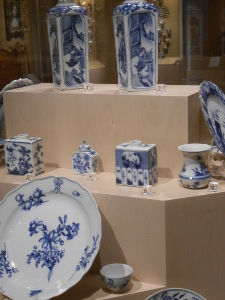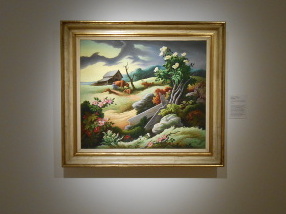 Museum entrance
Museum entrance Museum entrance
Museum entrance
We came to St. Augustine to do some family history, and were successful. But we found this city of 13,000 a tourist trap, crowded with winter Floridians dutifully exploring the oldest (European) city in the United States in what seemed like dozens of snaking tram trains.
Today St. Augustine was having a Celtic Festival and surely would be mobbed, so we headed north to the 12th largest city in the United States, Jacksonville.
These days on any Saturday there must be dozens of 5K or 10K runs somewhere in the U.S., and today thousands of Jacksonville women and men ran  German woodcarving
and jogged across the beautiful bridge over the Saint Johns River.
German woodcarving
and jogged across the beautiful bridge over the Saint Johns River.
But we managed to find our way past the bustling Saturday art market to the Cummer Museum of Art and Gardens where we spent several delightful hours. Located on the banks of the river, the museum is beautifully designed, with spacious galleries displaying a great variety of art.
There were sizeable discounts for seniors and military folks, so we  Garden view
enjoyed a cut-rate admission.
Garden view
enjoyed a cut-rate admission.
We found ourselves liking a great deal of the art on display -- which is not always the case. A special travelling exhibit entitled "Academic Splendor" featured nineteenth century works from the Dahesh. Another special exhibit had etchings and drypoint prints by American artists in Europe, many by Whistler, who was a master of this medium.
We visited the active childrens' area which was happily being used, and  Huge garden oak
stopped to watch some films depicting the house and gardens.
Huge garden oak
stopped to watch some films depicting the house and gardens.
Half-way through it was time for lunch, and the museum cafe has a top-flight chef. We shared a wonderful appetizer of cheese and fruits - blueberries, citron, candied pecans, crushed figs along with garlic toast. Then a great tomato bisque and salad finished the meal.
Happily replenished, we made our way to the rear of the museum  Meissen porcelain
(formerly the back of the Cummer home) where we found ourselves overlooking the impressive mile-wide Saint Johns River and an array of beautifully landscaped gardens. The gardens were ablaze with spring color -- dogwoods and azaleas and camellias and roses -- and featured landscapes designed by Ninah Cummer herself. Perhaps the most amazing feature was the double-size live oak whose limbs had dipped to the ground and taken root, so that the single tree appeared to be three.
Meissen porcelain
(formerly the back of the Cummer home) where we found ourselves overlooking the impressive mile-wide Saint Johns River and an array of beautifully landscaped gardens. The gardens were ablaze with spring color -- dogwoods and azaleas and camellias and roses -- and featured landscapes designed by Ninah Cummer herself. Perhaps the most amazing feature was the double-size live oak whose limbs had dipped to the ground and taken root, so that the single tree appeared to be three.
Back in the museum we saw more galleries including early 20th century art; the world's third most important collection of Meissen porcelain; and the  Thomas Hart Benton landscape
parlor of the Cummer home as it appeared when given to the museum.
Thomas Hart Benton landscape
parlor of the Cummer home as it appeared when given to the museum.
Mr. Cummer was a Canadian lumberman who was fortunate to take a big position in the tall southern pines, and built a railroad to haul the lumber to his Jacksonville mill. In the late nineteenth century, South Florida was much less accessible due to the lack of rail connections, and Jacksonville was a very stylish and popular winter destination.
We took our time returning to Saint Augustine, stopping for an afternoon blueberry smoothie.